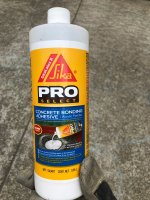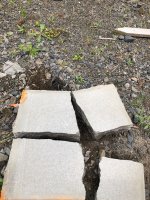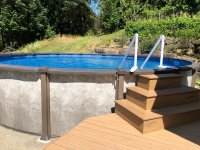Hi Folks,
I had to replace my old AGP that I installed several years ago because of rusting supports. Now that I have the new pool, I'm getting everything ready.
These are the old blocks I originally installed 5 years ago - so I'm hoping that when I lay out the new rail and supports, they'll all fall into the same location since its the same size pool. Will confirm when I take the rail and parts out of the box.
When I used a laser level, here are the differences from level for each block. 0" is of course the level reference. -" is under-height and +" is of course too high.
Some of these I'm being a little OCD on, like the 1/16" difference. But the ones that are way off (-5/8" & -1/2") those I'll probably pull up and use some cement bedding mix to raise the height?
Question on the -1/4" ones...has anyone tried using a latex thinset and skim coat the blocks to raise it? Thinset is usually pretty stable in < 1/2" thickness.

thanks,
-J
I had to replace my old AGP that I installed several years ago because of rusting supports. Now that I have the new pool, I'm getting everything ready.
These are the old blocks I originally installed 5 years ago - so I'm hoping that when I lay out the new rail and supports, they'll all fall into the same location since its the same size pool. Will confirm when I take the rail and parts out of the box.
When I used a laser level, here are the differences from level for each block. 0" is of course the level reference. -" is under-height and +" is of course too high.
Some of these I'm being a little OCD on, like the 1/16" difference. But the ones that are way off (-5/8" & -1/2") those I'll probably pull up and use some cement bedding mix to raise the height?
Question on the -1/4" ones...has anyone tried using a latex thinset and skim coat the blocks to raise it? Thinset is usually pretty stable in < 1/2" thickness.

thanks,
-J











